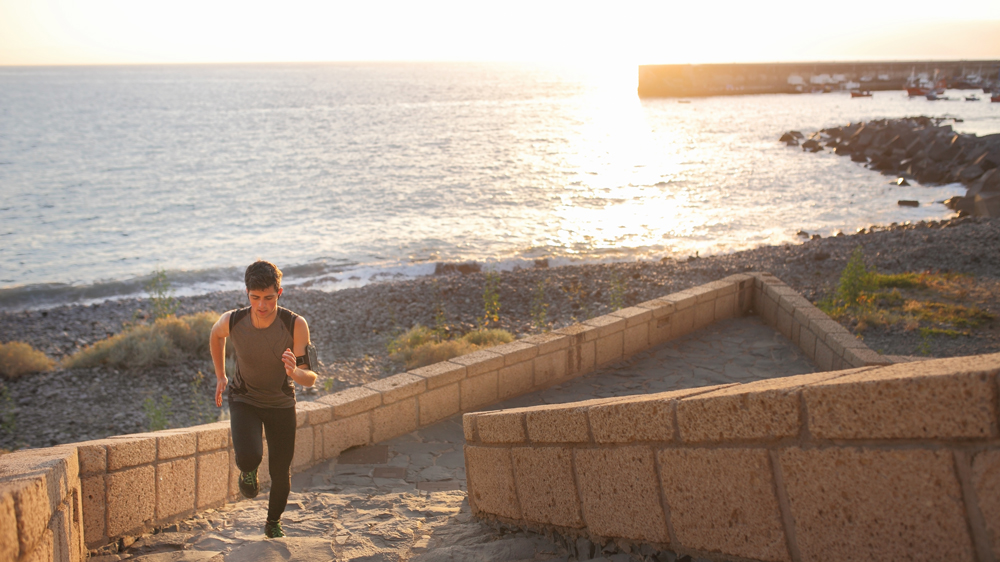Four Running Session Ideas To Change Things Up
You could plod around your nearest park again, or you could make a day of it with these open-air running ideas

Wet Sand Running
Why “Running on compacted wet sand allows you to run fast and hard without the same jarring impact on your joints you get from concrete,” says elite runner and coach Shaun Dixon (letsgetrunning.com).
How Unless you’re on a huge stretch of coastline you’re not going to be chalking up huge mileage (without running repeatedly back and forth). Instead use your time to work on speed and technique.
“The smooth and soft surface gives the option to whip off your shoes and practise running barefoot – top athletes include barefoot sprints to help them practise a fast, natural running technique,” says Dixon. “The surface is great to run ‘strides’, which are fast but relaxed sprints. After a ten-minute warm-up, run six to eight strides of around 20 seconds with a one-minute recovery jog between them.”
Dry Sand Running
Why “Dry sand is a soft, low-impact but challenging surface to run on, which makes it a really tough yet effective resistance-style session,” says Dixon.
How The soft surface significantly reduces the impact on your joints, connective tissues and muscles, which can all take a severe pounding when you run predominantly on the road.
“Dry sand still offers a really tough run – it’s an uneven surface and your feet want to sink into the sand with every stride, and the faster you run the harder it is to maintain that pace,” says Dixon. “So it’s a real lung-busting session that’s great for improving leg and joint strength. Try a shorter Fartlek-style session: after a thorough warm-up push the pace for one to three minutes, then slow down and jog to get your breath back, then push on again. Do this for 3-5km for a really effective workout.”
RECOMMENDED: Fartlek Explained
Get the Coach Newsletter
Sign up for workout ideas, training advice, reviews of the latest gear and more.
Trail Or Off-road Running
Why “I love running off the beaten track for a lower-impact run through beautiful scenery with undulating surfaces - it’ll keep you mentally engaged and enthused for the duration,” says Dixon.
How Running off-road can give you a brilliant workout and mental recharge by helping you reconnect to nature, but it’s essential to take precautions before setting out. “If you are running in another country during a holiday, or taking on a route you’ve not run before, it’s essential that you avoid taking unnecessary risks,” says Dixon.
“Make sure you know where you want to go, and stick to public footways and recognised paths. Safety must always come first, so take what you think you’ll need – water, snacks, a map, your phone, all in a running backpack – and if you can’t run with someone else, make sure someone knows where you are going and for roughly how long.”
RECOMMENDED: The Best Trail-Running Spots For Londoners
Hill Or Mountain Running
Why “A hill or mountain run is seriously challenging – one of the hardest runs you can do – but reaching the summit gives you an incredible buzz,” says Dixon.
How “Uphill running is a fantastic way to test your leg muscles, as well as your core and lower-body joints, in a different way from running on the flat,” says Dixon. “It’s especially good for your glutes because they must drive hard to keep you propelled upwards with each step.”
When you come back down, though, watch your speed. “Running too fast downhill can cause your feet to slip, and your quads may be sore for days afterwards if you work them too hard during your descent. The bigger the peak, the greater the weather difference can be, so always prepare for all eventualities. And safety must come first – do your research and take the same precautions as when you’re trail running.”
RECOMMENDED: Four Great Benefits Of Hill Running
Coach is a health and fitness title. This byline is used for posting sponsored content, book extracts and the like. It is also used as a placeholder for articles published a long time ago when the original author is unclear. You can find out more about this publication and find the contact details of the editorial team on the About Us page.

